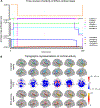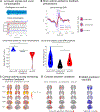DIVA Meets EEG: Model Validation Using Formant-Shift Reflex
- PMID: 38435340
- PMCID: PMC10906992
- DOI: 10.3390/app13137512
DIVA Meets EEG: Model Validation Using Formant-Shift Reflex
Abstract
The neurocomputational model 'Directions into Velocities of Articulators' (DIVA) was developed to account for various aspects of normal and disordered speech production and acquisition. The neural substrates of DIVA were established through functional magnetic resonance imaging (fMRI), providing physiological validation of the model. This study introduces DIVA_EEG an extension of DIVA that utilizes electroencephalography (EEG) to leverage the high temporal resolution and broad availability of EEG over fMRI. For the development of DIVA_EEG, EEG-like signals were derived from original equations describing the activity of the different DIVA maps. Synthetic EEG associated with the utterance of syllables was generated when both unperturbed and perturbed auditory feedback (first formant perturbations) were simulated. The cortical activation maps derived from synthetic EEG closely resembled those of the original DIVA model. To validate DIVA_EEG, the EEG of individuals with typical voices (N = 30) was acquired during an altered auditory feedback paradigm. The resulting empirical brain activity maps significantly overlapped with those predicted by DIVA_EEG. In conjunction with other recent model extensions, DIVA_EEG lays the foundations for constructing a complete neurocomputational framework to tackle vocal and speech disorders, which can guide model-driven personalized interventions.
Keywords: DIVA model; EEG; auditory feedback; feedback perturbation; vocal compensation.
Conflict of interest statement
Conflicts of Interest: M.Z. and A.W. have a financial interest in Lanek SPA, a company focused on developing and commercializing biomedical devices and technologies. Their interests were reviewed and are managed by Universidad Técnica Federico Santa María and Universidad de Valparaíso, respectively, in accordance with their conflict-of-interest policies.
Figures






Similar articles
-
The integration of large-scale neural network modeling and functional brain imaging in speech motor control.Neuroimage. 2010 Sep;52(3):862-74. doi: 10.1016/j.neuroimage.2009.10.023. Epub 2009 Oct 23. Neuroimage. 2010. PMID: 19837177 Free PMC article.
-
Modelling speech motor programming and apraxia of speech in the DIVA/GODIVA neurocomputational framework.Aphasiology. 2021;35(4):424-441. doi: 10.1080/02687038.2020.1765307. Epub 2020 May 18. Aphasiology. 2021. PMID: 34108793 Free PMC article.
-
Sensorimotor control of vocal pitch and formant frequencies in Parkinson's disease.Brain Res. 2016 Sep 1;1646:269-277. doi: 10.1016/j.brainres.2016.06.013. Epub 2016 Jun 8. Brain Res. 2016. PMID: 27288701 Free PMC article.
-
Role of the auditory system in speech production.Handb Clin Neurol. 2015;129:161-75. doi: 10.1016/B978-0-444-62630-1.00009-3. Handb Clin Neurol. 2015. PMID: 25726268 Review.
-
On the interplay between speech perception and production: insights from research and theories.Front Neurosci. 2024 Jan 25;18:1347614. doi: 10.3389/fnins.2024.1347614. eCollection 2024. Front Neurosci. 2024. PMID: 38332858 Free PMC article. Review.
Cited by
-
Modeling voice production and self-perception in noise: Understanding the Lombard effect in non-phonotraumatic vocal hyperfunctiona).J Acoust Soc Am. 2024 Dec 1;156(6):3772-3779. doi: 10.1121/10.0034544. J Acoust Soc Am. 2024. PMID: 39642290
-
Childhood Apraxia of Speech: A Descriptive and Prescriptive Model of Assessment and Diagnosis.Brain Sci. 2024 May 24;14(6):540. doi: 10.3390/brainsci14060540. Brain Sci. 2024. PMID: 38928540 Free PMC article.
References
-
- Scheerer NE; Jones JA The Predictability of Frequency-Altered Auditory Feedback Changes the Weighting of Feedback and Feedforward Input for Speech Motor Control. Eur. J. Neurosci 2014, 40, 3793–3806. - PubMed
-
- Parrell B; Lammert AC; Ciccarelli G; Quatieri TF Current Models of Speech Motor Control: A Control-Theoretic Overview of Architectures and Properties. J. Acoust. Soc. Am 2019, 145, 1456–1481. - PubMed
-
- Guenther FH Neural Control of Speech; The MIT Press: Cambridge, MA, USA, 2016; ISBN 978-0-262-33698-7.
Grants and funding
LinkOut - more resources
Full Text Sources
